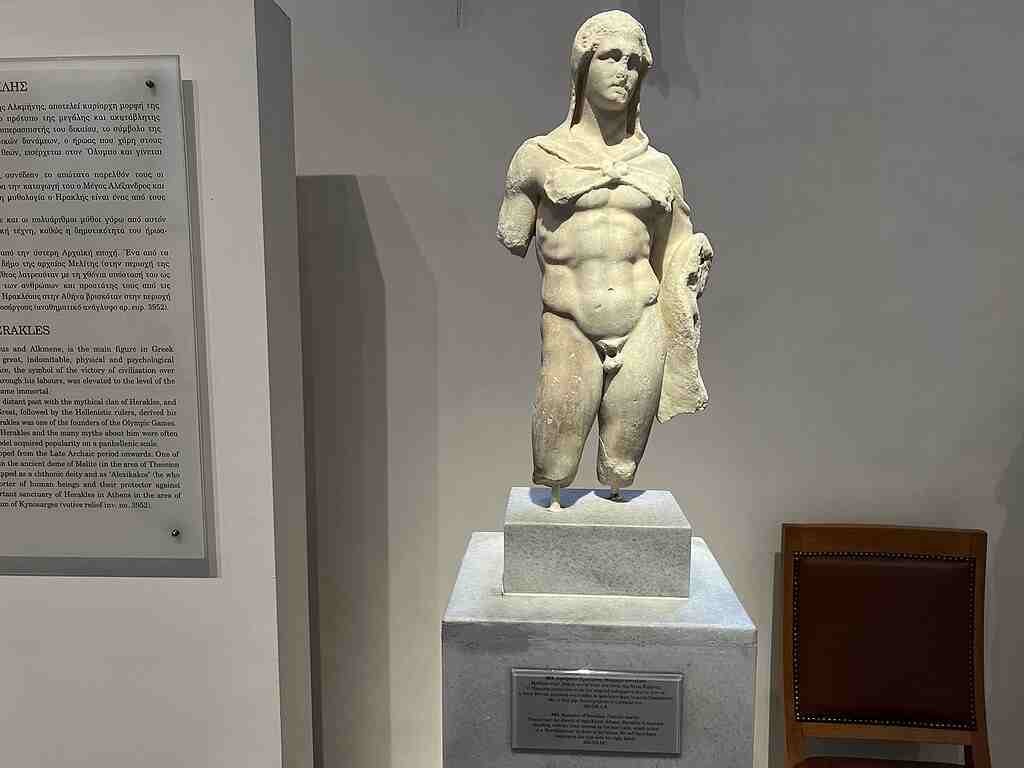Heracles: who is this demi-god better known as Hercules?
Heracles Demigod, the most famous of the Greek heroes, is famous for his courage, his strength, his compassion and his generous character, as great in his benefits as in his excesses. Often invoked under the name of alexikakos, the one who diverts evils, he embodies the being who acts for the good of men. The Greeks remember this double dimension of the hero-god, and offer him their sacrifices, Herodotus tells us, sometimes according to the heroic ritual, sometimes according to the divine ritual, (II, 44). In the fight against the Giants, he helps the Immortals and fights alongside Athena as a human, because the gods facing the giants, their rivals who also want immortality, need a human at their side.
He will be nicknamed “Giant killer” (Sophocles, Trachiniennes, 1058-1059). Embodying the highest human virtues, he becomes a universal model of humanity and an edifying example in Isocrates for example (Eloge d’Hélène 23-24).
From birth, the formidable physical strength of the man known in particular for the 12 labors of Hercules is beyond doubt. If this gift could have made his life easier, fate decided otherwise, because the life of Heracles is a long series of trials that will take him to the four corners of the world.
Who are the parents of Hercules?
The birth of Hercules is special since it is a demi-god. “He is the son of Zeus, king of the Olympians, and a mortal, Alcmene”, says Barbara Cassin. He is the fruit of the terrible metamorphosis of Zeus who, to seduce Alcmene, takes on the appearance of her husband, Amphitryon. “She opens her arms and her bed to him and becomes pregnant with Hercules”, details the philologist. Named Alcide, Zeus will then decide to rename him Heracles – to the glory of Hera – in the hope of allaying his wife’s anger.
Amphitryon will raise the child as his own, but Hercules will be subjected throughout his existence to Hera, the wife of Zeus, mad with rage at having been deceived by her husband.
Love lives
He first married Megara the daughter of Creon but in a fit of madness he killed her and their children.
He had, in many places, amorous adventures (the daughters of King Thespios, Augé with whom he had a son Telephus…) and he even forgot his heroism by becoming the slave of Queen Omphale.
Finally, he married Déjanire, whom he left for Iolé. Dejanira sent her fickle husband a tunic soaked in the poisonous blood of Nessos. No sooner had he put on the garment than he felt his flesh burning and saw his body being consumed. So he erected a pyre on Mount Oeta, and threw himself into the flames.
Then he was admitted to Olympus, and received immortality and married Hebe.
With his many concubines he had a large descendant of nearly eighty children.
The demigod Herakles, son of Zeus and Alcmene, is the main figure in Greek mythology embodying the model of great, indomitable, physical and psychological strength. In Athens, Herakles was worshipped from the Late Archaic period onwards. Photo taken by www.PinterPandai.com in National Archaeological Museum, Athens, Greece. Pinterpandai.com, CC BY-SA 4.0, via Wikimedia Commons
The Labors of Heracles Demigod: a famous episode from Greek mythology
“Hercules will be all his life obliged to redeem his birth from Hera”, deciphers Barbara Cassin. Driven mad by the goddess, Heracles kills his children and his wife, before consulting the Pythia in the hope of expiating his fault. Placed at the service of his enemy Eurystheus, he will have to accomplish a series of tasks: the Labors of Heracles, better known as the 12 Labors of Hercules. It is an episode famous to the point of having entered our everyday language. Herculean work will, by definition, be impossible to accomplish.

Roman relief (3rd century AD) depicting a sequence of the Labours, representing from left to right the Nemean lion, the Lernaean Hydra, the Erymanthian Boar, the Ceryneian Hind, the Stymphalian birds, the Girdle of Hippolyta, the Augean stables, the Cretan Bull and the Mares of Diomedes. Museo nazionale romano di palazzo Altemps, Public domain, via Wikimedia Commons
What are the 12 Labors of Hercules?
1 – Kill the Nemean lion, an animal reputed to be invulnerable and bring back its skin.
2 – Kill the Lernaean Hydra, a monster with multiple regenerating heads.
3 – Capture the doe of Cerynia, an animal with golden horns and brazen hooves protected by the goddess Artemis.
4 – Capture the Erymanthian Boar, a huge beast that terrified the people of Arcadia.
5 – Clean in one day the stables of Augeas where manure was accumulating.
6 – Hunt Stymphalian Lake birds, carnivorous birds that killed their prey using the tips of their wings.
7 – Tame and bring back the Cretan bull of King Minos which he had refused to return to the god Poseidon.
8 – Capture the mares of the king of Thrace, Diomedes, whom he fed with human flesh.
9 – Bring back the belt of Hippolyte, Queen of the Amazons.
10 – Steal the herd of oxen from Geryon, a giant with three bodies.
11 – Bring back the golden apples from the Garden of the Hesperides guarded by a five-headed dragon, Ladon.
12 – Bring back Cerberus, the three-headed dog guarding the entrance to the Underworld.
The hero’s death
Persuading of Lichas’ treachery, Hercules throws him into the sea EuboeaHercules throws Lichas into the sea
After these twelve labors, Hercules continued his exploits, some of which are very famous. The legend says that he married Deianira, won over to his rival Antaeus, son of Poseidon.
One day, the centaur Nessus attacked Dejanira to rape her: Hercules wounded him with one of the arrows poisoned by the blood of the Hydra. Unfortunately, the dying centaur advised Deianira to take some of this blood: it was, he told her, a powerful love potion. In reality, it was a poison.
Déjanira treasured it and, when she believed that Hercules had fallen in love with Princess Iole, she had Lichas wear to her husband a tunic that she had dipped in this blood. No sooner had he put it on than Hercules felt the burn of the poison; every time he tried to take it off. Thinking of a treachery of Lichas, he grabbed him by the foot, twirled him around and threw him into the Euboea Sea.
He tore shreds of skin, but the pain was so intense that he preferred to end it by throwing himself into the flames of a funeral pyre. After his death, the gods carried him to Olympus and gave him as wife Hebe, goddess of Youth.
The Greeks worshiped Hercules both as a god and as a mortal hero. He is usually represented as a muscular man, with a powerful build, dressed in a lion’s skin and carrying a club.
Sources: PinterPandai, History, Britannica, GreekMythology
Photo credit: PinterPandai (CC BY-SA 4.0) via Wikimedia Commons
Photo description: Heracles is a divine protector of mankind, patron of gymnasium Heracles, the most famous of the Greek heroes, is famous for his courage, his strength, his compassion and his generous character, as great in his benefits as in his excesses. Often invoked under the name of alexikakos, the one who diverts evils, he embodies the being who acts for the good of men. Photo taken by www.PinterPandai.com in National Archaeological Museum, Athens, Greece.



